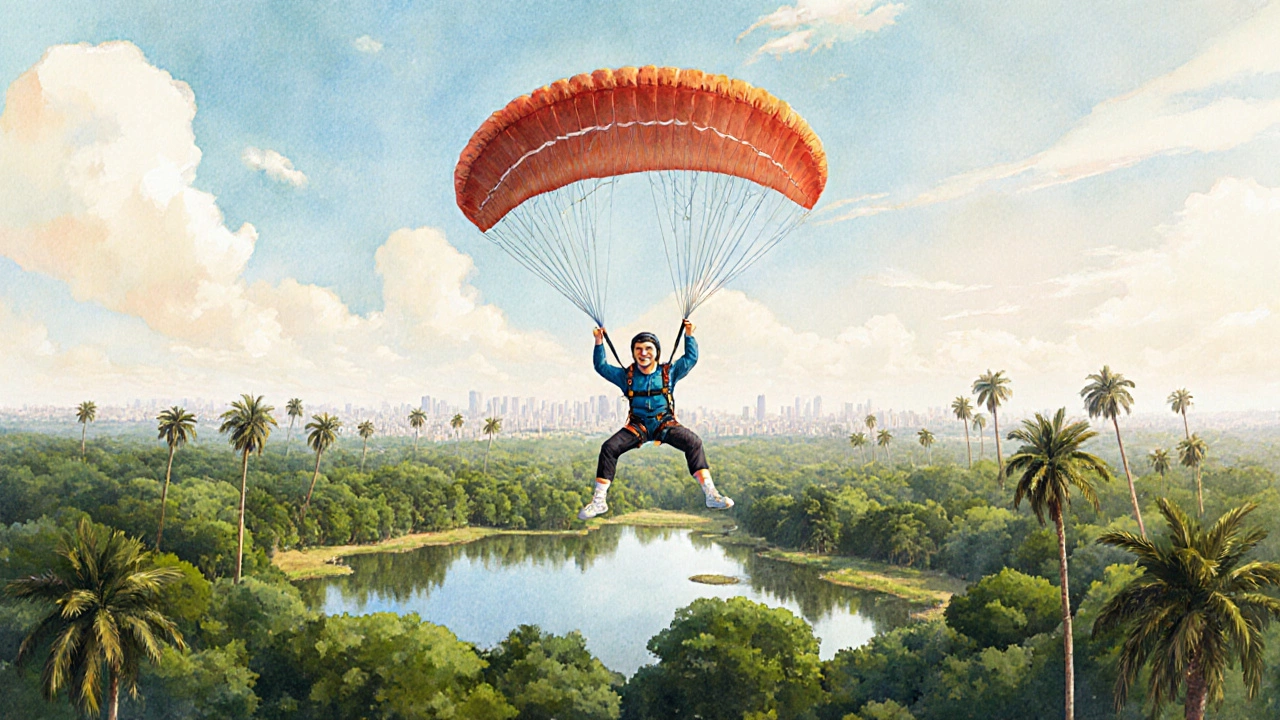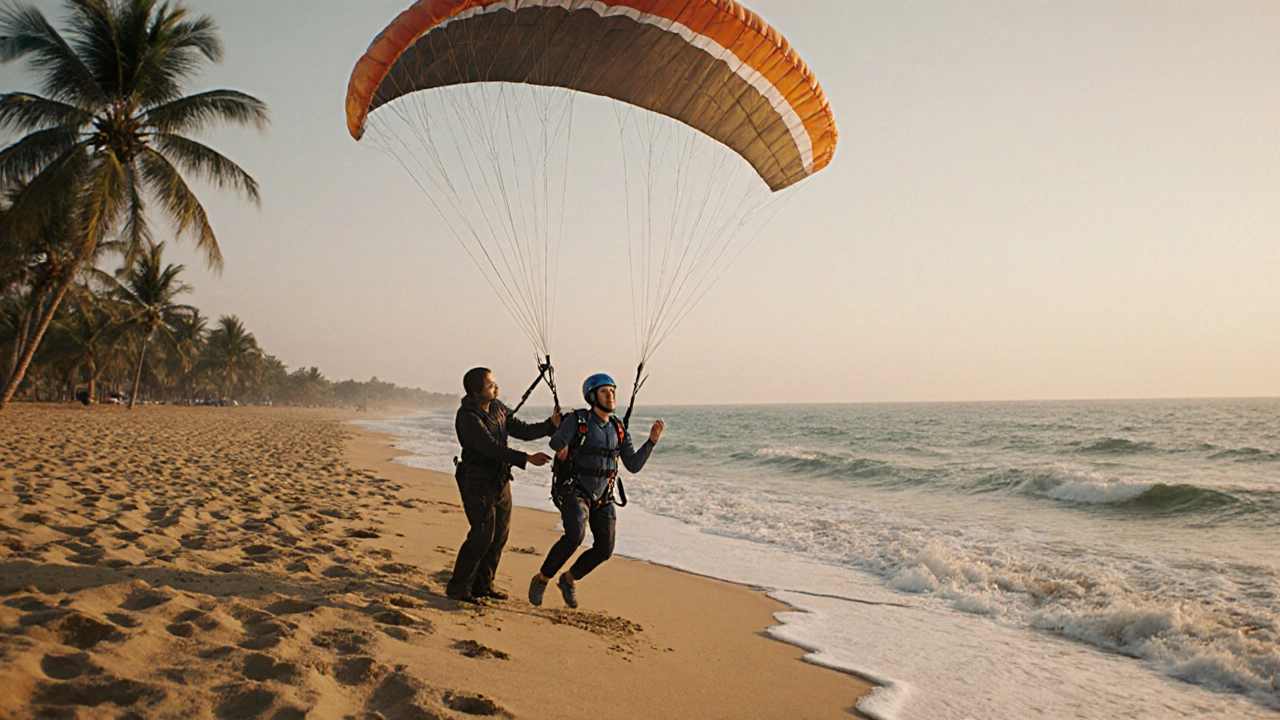Skydiving Cost Calculator
Customize Your Skydive
Your Estimated Cost
Select options to see your cost
Note: Amritsar and Bangalore offer discounts during monsoon shoulder months (October and April) when weather is stable but crowds are smaller.
Yes, skydiving is available in India - and it’s not just a dream for adrenaline seekers anymore. Over the last five years, tandem skydiving has gone from a rare novelty to a growing adventure sport with multiple licensed operators across the country. If you’ve ever wondered whether you can jump out of a plane over the Indian landscape, the answer is a clear yes. You don’t need to fly to Dubai or New Zealand to experience freefall. India has its own drop zones, certified instructors, and safety standards that meet international guidelines.
Where Can You Skydive in India?
There are three main locations in India where you can legally and safely do a tandem skydive:
- Amritsar, Punjab - Home to the country’s oldest and most established skydiving center, Skydive India operates from the Amritsar Airfield. This is the go-to spot for first-timers, with jumps over the flat plains of Punjab offering clear views of the Golden Temple in the distance on clear days.
- Bangalore, Karnataka - The Bangalore Skydiving Club uses a private airfield near Devanahalli, about 40 km from the city. It’s popular among urban professionals and expats, with jumps happening over forested areas and small lakes. The weather here is favorable for most of the year.
- Goa - For those who want to skydive over the coast, Skydive Goa offers jumps from 15,000 feet above the Arabian Sea. The views of beaches, palm trees, and the ocean below make this one of the most scenic drops in the country.
Each location uses American-made Cessna 182 aircraft and USPA-certified instructors. All gear is inspected daily, and every jump is recorded with a helmet cam - you get a video of your freefall and landing included in the price.
How Much Does Skydiving Cost in India?
A tandem skydive in India typically costs between ₹25,000 and ₹35,000 (roughly $300-$420 USD). That price includes:
- Training session (30-45 minutes)
- Jump from 10,000 to 15,000 feet
- 45-60 seconds of freefall at 120 mph
- 5-7 minutes under the parachute
- Professional video and photo package
- Certificate of completion
Prices vary slightly by location and season. Goa tends to be the most expensive due to high demand and scenic value. Amritsar and Bangalore often offer discounts during monsoon shoulder months (October and April) when weather is still stable but crowds are smaller.
There are no hidden fees. Unlike some operators abroad, Indian skydiving centers don’t charge extra for gear rental or insurance - it’s all included. The only extra cost is if you want to upgrade to a higher altitude (18,000 feet) or add a drone capture, which adds ₹5,000-₹8,000.
Who Can Skydive in India?
Most people can skydive - if they’re in decent physical shape. Here are the basic requirements:
- Age: Minimum 18 years old. No exceptions. Parental consent doesn’t count - Indian regulations are strict on this.
- Weight: Maximum 100 kg (220 lbs) for tandem jumps. Some centers may allow up to 110 kg with an additional fee and instructor approval.
- Health: No heart conditions, severe back or neck issues, or recent surgeries. You’ll be asked to sign a health declaration form. If you’re pregnant, diabetic, or have epilepsy, you won’t be allowed to jump.
- Weather: Jumps are weather-dependent. Wind speed, cloud cover, and visibility determine if you jump. Most centers offer a free reschedule if weather cancels your jump.
There’s no need for prior experience. Tandem skydiving means you’re strapped to a certified instructor the entire time. You don’t control anything - just enjoy the ride. You’ll be briefed on body position, landing cues, and what to expect during freefall. Most people say the training is simpler than learning to ride a bike.

Is Skydiving Safe in India?
Safety is the top priority for every licensed skydiving center in India. All operators are registered with the Aero Club of India and follow guidelines set by the Directorate General of Civil Aviation (DGCA). Equipment is maintained to FAA and USPA standards, and every parachute system includes both a main and reserve chute - both packed by certified riggers.
Statistics from Skydive India show a 99.97% safety rate over the last 12 years, with zero fatal accidents in tandem jumps. Most incidents involve minor injuries like twisted ankles on landing - usually from not following instructor cues. That’s why the pre-jump training matters. Listen carefully. Don’t panic. Keep your body straight. You’ll land on your feet.
Unlike some countries where skydiving is done by unlicensed operators, India has cracked down hard on illegal jumps. If a center doesn’t have a DGCA license, it’s not legal - and you shouldn’t jump there. Always check the operator’s license number on the DGCA website before booking.
What to Expect on Jump Day
Here’s what your day will look like:
- Arrive early: Most centers ask you to show up by 7:30 AM. The flight window opens at 8:00 AM, and delays happen if weather changes.
- Check-in and paperwork: You’ll sign a waiver and fill out a health form. Bring your ID - no exceptions.
- Training: A 30-45 minute session covers body position, hand signals, and landing instructions. You’ll practice the landing stance on the ground.
- Get geared up: You’ll wear a jumpsuit, helmet, goggles, and harness. Your instructor will attach you to their harness.
- Board the plane: The Cessna climbs to 10,000-15,000 feet. It takes about 15-20 minutes. You’ll feel the altitude change - ears pop, but no oxygen mask is needed.
- Jump: At the door, your instructor counts down: “3… 2… 1… GO!” You’ll fall for 45-60 seconds. The sensation? Not like in movies. It’s more like floating, with wind rushing past your face. No stomach-dropping feeling.
- Parachute opens: At 5,000 feet, the chute deploys. Suddenly, it’s quiet. You’ll glide for 5-7 minutes. Your instructor will let you steer a little - pull left, turn left. You’ll see everything below: farms, rivers, cities, or the ocean.
- Landing: You’ll land on your feet. Most landings are gentle. Some feel like stepping off a curb. You’ll be helped off the ground, handed your video, and given your certificate.
Plan for 3-4 hours total. Weather delays can push it to 5 hours, so don’t schedule anything urgent right after.

What to Wear and Bring
You don’t need special gear. Just wear:
- Comfortable, snug-fitting clothes (no loose shirts or skirts)
- Sneakers or sports shoes (no sandals, boots, or heels)
- Sunglasses (provided if you don’t have them)
- Nothing in your pockets - phones, keys, wallets go in lockers
Bring:
- Government ID (passport or Aadhaar card)
- Water and light snacks (food isn’t provided)
- A change of clothes (you’ll sweat)
- A friend or family member to watch - most centers have viewing areas
Don’t wear jewelry, watches, or necklaces. They can get caught during the jump. Leave them in your car or with someone on the ground.
Is Skydiving Worth It in India?
For many, it’s the most memorable experience of their life. People who’ve jumped say it changes how they see fear, limits, and freedom. The views are stunning - from the golden fields of Punjab to the turquoise waters of Goa. The adrenaline rush lasts longer than any rollercoaster.
It’s not cheap, but compared to doing it abroad, it’s a bargain. You get the same safety standards, same gear, same training - just without the flight to another continent. Plus, you’re supporting local adventure tourism.
If you’ve ever thought about skydiving, now is the time. India has the infrastructure. The operators are professional. The weather is good for 8-9 months a year. And the memories? Priceless.
Is skydiving legal in India?
Yes, skydiving is legal in India, but only through licensed operators approved by the Directorate General of Civil Aviation (DGCA). There are only three official drop zones: Amritsar, Bangalore, and Goa. Any other operation offering skydiving without a DGCA license is illegal and unsafe.
Can tourists do skydiving in India?
Absolutely. Tourists from any country can skydive in India as long as they’re 18 or older, meet the weight limit (under 100 kg), and have a valid passport or government ID. No visa is required specifically for skydiving - your regular tourist visa is enough.
What’s the best time of year to skydive in India?
The best months are October to March. During this period, skies are clear, winds are calm, and humidity is low. April and May can be hot and hazy. The monsoon (June-September) makes jumping unsafe due to rain and strong winds. Most centers close during peak monsoon months.
Do I need to book in advance?
Yes, always book at least 3-5 days ahead, especially during weekends and holidays. Skydiving centers limit the number of jumps per day due to aircraft capacity and safety protocols. Walk-ins are rarely accepted.
Can I bring my own camera?
No. Personal cameras, phones, or GoPros are not allowed during the jump. They can interfere with equipment or become loose during freefall. All video and photos are handled by your instructor’s helmet cam. You’ll receive a high-quality clip and a few stills after landing.
What happens if the weather is bad on my jump day?
If weather prevents your jump, you’ll be offered a free reschedule - no extra charge. Most centers allow you to pick a new date within 6 months. Some even refund your deposit if you can’t reschedule. Always confirm their policy before booking.
